|
|
|
Sort Order |
|
|
|
Items / Page
|
|
|
|
|
|
|
| Srl | Item |
| 1 |
ID:
189425
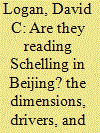

|
|
|
|
|
| Summary/Abstract |
Experts increasingly highlight the dangers of nuclear-conventional entanglement, particularly in the U.S.-China context. This article develops a framework for assessing entanglement and its risks. Applying that framework to China, it finds that Beijing’s missiles are not as entangled as is sometimes feared, but ongoing trends may increase future entanglement. It also presents evidence that, counter to the prevailing wisdom, Chinese entanglement has not emerged as a strategic policy choice but, rather, as the byproduct of more parochial organizational dynamics. Strategic signaling and perception management will be key to controlling escalation risks stemming from nuclear-conventional entanglement in China.
|
|
|
|
|
|
|
|
|
|
|
|
|
|
|
|
| 2 |
ID:
114823
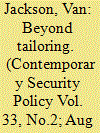

|
|
|
|
|
| Publication |
2012.
|
| Summary/Abstract |
How can one state maintain deterrence against another state undergoing an uncertain political transition? A debate within fourth wave deterrence theory focuses on whether and when a tailored approach, based on cultural, organizational, and idiosyncratic characteristics of a target state, has the greatest value. Tailored deterrence may not be appropriate under conditions of domestic political uncertainty in the target state, often those most in need of deterring. A more promising alternative for a defending state may be deterrence management. Deterrence management compensates for insufficient or low-confidence assessments of a target's values, organizational structure, power distribution, or cultural idiosyncrasies that prevent employment of tailored deterrence strategies intended to manipulate such factors. To make this case, I combine insights from deterrence theory with an exploration of the uncertain politics of a post-Kim Jong-il North Korea and the unpredictable process of power consolidation. Deterrence management may be applicable in cases of imperceptible leadership transitions in other target states. While no panacea, the deterrence management approach reinforces stability while remaining flexible enough to accommodate change.
|
|
|
|
|
|
|
|
|
|
|
|
|
|
|
|
| 3 |
ID:
112452
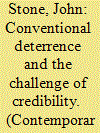

|
|
|
|
|
| Publication |
2012.
|
| Summary/Abstract |
The concept of 'credibility' is a central component of deterrence theory. In this article, credibility is used as a lens through which to examine the effectiveness of conventional force as a deterrent. An advantage that conventional force enjoys over its nuclear counterpart is that it can be used with much greater discrimination. Conventional threats can, therefore, be considered more politically credible than nuclear threats under all but the most extreme circumstances. Conversely, the relatively modest power of conventional weapons renders their effects 'interpretable' to a problematic degree by potential aggressors. Thus, such threats are less likely to be as technically credible as their nuclear equivalents. A range of communicative efforts may serve to reduce the scope for interpreting the effects possible to conventional weapons, although efforts of this kind risk being hampered by cultural obstacles. In consequence, success with conventional deterrence will turn on the ability to identify the specific technical and cultural conditions under which credible threats can readily be made.
|
|
|
|
|
|
|
|
|
|
|
|
|
|
|
|
| 4 |
ID:
151422
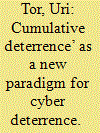

|
|
|
|
|
| Summary/Abstract |
This article suggests that there is a paradigm crisis in the sub-field of cyber deterrence. Cyber deterrence is evolving slowly and unpromisingly as a strategic tool in both theory and practice, mostly due to the ill-fitting theoretical framework and underlining assumptions it borrows from the absolute-nuclear-deterrence context. Therefore, this article suggests replacing the accepted yet inadequate paradigm of absolute deterrence with a better-fitting restrictive-cumulative-deterrence paradigm that draws on the Israeli approach to deterrence, introducing it into the cyber domain. The article further criticizes the current discourse in the field, including some ‘common knowledge’ (mis)understandings of cyberspace and the ways it affects the possibility of deterrence.
|
|
|
|
|
|
|
|
|
|
|
|
|
|
|
|
| 5 |
ID:
157894
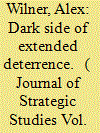

|
|
|
|
|
| Summary/Abstract |
States employ extended deterrence to shield third parties from aggression. The concept is traditionally applied to interstate relations, collective security arrangements, and strategic considerations. The protective relationship that exists between a state sponsor of terrorism and its non-state militant proxy is rarely considered. This article will introduce and explore the sponsor–proxy relationship in the context of extended deterrence, and relate it to Iran’s support and sponsorship of political violence, militancy, and terrorism in Europe. The article reviews the rationale states have for sponsoring terrorism, and illustrates the promises and pitfalls associated with extending deterrence to non-state militants.
|
|
|
|
|
|
|
|
|
|
|
|
|
|
|
|
| 6 |
ID:
190773
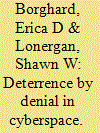

|
|
|
|
|
| Summary/Abstract |
Many scholars and practitioners are unconvinced that cyber deterrence is possible. This article aims to demonstrate why some of this skepticism is misplaced, as well as provide greater clarity and conceptual rigor to the proliferation of arguments within the United States about deterrence in cyberspace. Specifically, we argue that cyber deterrence frameworks that draw from the traditional nuclear deterrence literature and the logic of deterrence by punishment are mismatched to deterrence challenges in cyberspace. Instead, we advocate for a deterrence by denial approach, but one that is oriented around counter-cyber operations rather than simply improving defenses. While there has been some scholarship and work by practitioners that implicitly rests on a deterrence by denial logic, they suffer from a lack of systematic assessment of how traditional denial concepts, especially those developed in the conventional deterrence literature, could be extended to cyberspace. Therefore, in this article, we review different deterrence concepts in theory and practice, articulate a logic of cyber deterrence by denial, and provide policy recommendations for the United States.
|
|
|
|
|
|
|
|
|
|
|
|
|
|
|
|
| 7 |
ID:
102437
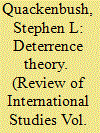

|
|
|
|
|
| Publication |
2011.
|
| Summary/Abstract |
Although deterrence theory was a central focus in the study of International Relations during the Cold War, attention has shifted away from deterrence since the end of that conflict. Nonetheless, deterrence is a general phenomenon that is not limited to any particular time or space. Moving beyond a simple focus on the US-Soviet relationship, scholars have recently begun further explorations of deterrence, through development of theory, analysis of policy alternatives, and empirical analysis. This article seeks to evaluate where deterrence theory stands today through: (1) a consideration of distinctions between different strands of theory; (2) a discussion of the assumption of rationality in deterrence theory; (3) an examination of three important distinctions in deterrence; (4) an evaluation of the difficult task of testing deterrence theory, and (5) an overview of recent theoretical developments. The primary conclusion is that perfect deterrence theory provides a logically consistent alternative to classical deterrence theory and therefore provides the most appropriate basis for further theoretical development, empirical testing, and application to policy.
|
|
|
|
|
|
|
|
|
|
|
|
|
|
|
|
| 8 |
ID:
102370
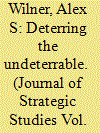

|
|
|
|
|
| Publication |
2011.
|
| Summary/Abstract |
This article argues that deterrence theory can be applied to counterterrorism. Doing so requires broadening the traditional concept of deterrence by punishment, expanding deterrence by denial to include defense, mitigation, and strategic hindrance, and developing deterrence by delegitimization to influence the political, ideological, and religious rationales informing terrorist behavior. In practice, deterring terrorism requires tailoring threats against state and individual facilitators, diffusing the intended consequences of terrorism, and manipulating terrorist self-restraints. When these and other deterrent leverages are applied simultaneously against various actors and processes involved in terrorism, coercion can be achieved.
|
|
|
|
|
|
|
|
|
|
|
|
|
|
|
|
| 9 |
ID:
099107
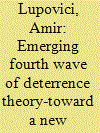

|
|
|
|
|
| Publication |
2010.
|
| Summary/Abstract |
In this paper, I aim to review recent empirical and theoretical developments in the study of deterrence. I suggest that an emerging wave of literature currently represents a revival in this field. However, unlike the previous waves, in which theoretical and empirical questions were studied together (realism and nuclear deterrence), in the emerging deterrence literature these two are isolated from each other. The theoretical trend of this wave is evident in new constructivist and interpretative scholarship that explores the practices of deterrence and has provided significant insights, chiefly with regard to classical empirical questions of state versus state and nuclear deterrence. The empirical trend of this wave can be seen through the work of scholars who are considering how to deter "new" threats-such as terrorism, rogue states, and ethnic conflicts-mainly by incorporating the traditional realist approach to deterrence. By reviewing these two trends in the current wave of deterrence writing, I demonstrate the advantages of each and suggest that the study of deterrence may benefit from their integration.
|
|
|
|
|
|
|
|
|
|
|
|
|
|
|
|
| 10 |
ID:
141729
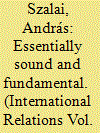

|
|
|
|
|
| Summary/Abstract |
Faced with the strategic uncertainties of the early nuclear age, the US Air Force (USAF) turned to civilian experts (defense rationalists) for help. Although the two communities shared the perception that science-based policies were required, the marriage of two distinct traditions – military and scientific – was not without conflict. Using an interpretivist approach, this article investigates this problematic reconciliation. It construes the realm of nuclear strategy-making as an interpretive enterprise where a multitude of ideas competed. Experts in this environment influenced policy decisions by rendering their ideas persuasive for their military ‘patrons’ through narrative framing devices. Within this conceptualization, bureaucratic dilemmas faced by the patron offered opportunities for experts to establish metaphorical correspondence between their tradition and the patron’s tradition. Such correspondence then lent ideas legitimacy and encouraged organizational support. As an illustration, an analysis is conducted on the role that hallmark RAND ideas on war limitation played in the so-called ‘counterforce’ debate in the early 1960s. This case suggests that the lasting impact of deterrence ideas had less to do with their correspondence to reality, than with their versatility as carriers of constructed ‘scientific’ and ‘rational’ storylines that gained traction within the USAF.
|
|
|
|
|
|
|
|
|
|
|
|
|
|
|
|
| 11 |
ID:
173991
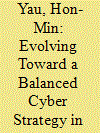

|
|
|
|
|
| Summary/Abstract |
This paper investigates the limits of implementing a cyber deterrence strategy in East Asia. Given that national security documents from both Taiwan and Japan indicate the need to deter state-sponsored cyberattacks, there is very little literature that empirically and theoretically investigates the utility of such an approach in this region. This paper looks into the various deterrence constructs and argues that none of them can be implemented without problems. The paper looks further into a deeper level of the conceptual issues upon which deterrence thinking is based and argues that an alternative strategy promoting regional cooperation is not only possible but also desirable in the current political climate. It is later concluded that looking for a one-size-fits-all solution is idealistic, and policymakers should develop security countermeasures that align with the threats posed by the actors they wish to confront.
|
|
|
|
|
|
|
|
|
|
|
|
|
|
|
|
| 12 |
ID:
097848
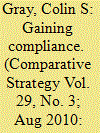

|
|
|
| 13 |
ID:
114958
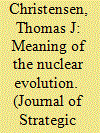

|
|
|
|
|
| Publication |
2012.
|
| Summary/Abstract |
Will China's development of a new generation of nuclear weapons impact US-China security relations in important ways? One's answer depends on how one views the following: whether or not Chinese leaders believe that they are only now acquiring a secure second strike capability; the scope of coercive power that secure second strike capability provides to conventionally inferior actors; the meaning of China's 'No First Use' Doctrine; and the prospects for escalation control in future crises. Applying Cold War theories and tapping Chinese doctrinal writings this article concludes that China's nuclear modernization program might prove more consequential than is commonly believed.
|
|
|
|
|
|
|
|
|
|
|
|
|
|
|
|
| 14 |
ID:
128304
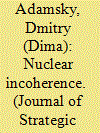

|
|
|
|
|
| Publication |
2014.
|
| Summary/Abstract |
Russian reliance on its non-strategic nuclear arsenal has been an ongoing concern for security experts. What is the Russian de facto employment doctrine for this arsenal? This article argues that Russian non-strategic nuclear weapons (NSNW) have no defined mission and no deterrence framework has been elaborated for them. This study disentangles Russian thoughts and deeds about regional nuclear deterrence and the role of NSNW in it. Situating the Russian case in the comparative context, the article argues that establishing a coherent theater nuclear posture and streamlining it with the national level deterrence strategy is a demanding and frequently unfulfilled task. It is likely to remain as such for both current and prospective nuclear states that consider an asymmetrical deterrence posture.
|
|
|
|
|
|
|
|
|
|
|
|
|
|
|
|
| 15 |
ID:
195346


|
|
|
|
|
| Summary/Abstract |
Game theoretic analysis of deterrence has been criticized for not capturing how actors realistically behave. It is alleged that prospect theoretical re-modeling provides a better foundation for a deterrence theory. The article analyzes how the strategies change when a prospect theoretical function is applied to a central deterrence game. While the probability distributions changes, it cannot alter the general dynamics. When considered together with previous research, it shows that prospect theory neither can or should replace standard assumptions when constructing a deterrence theory. However, viewed as a compliment, prospect theory expands the modeling possibilities and opens up for important new aspects.
|
|
|
|
|
|
|
|
|
|
|
|
|
|
|
|
| 16 |
ID:
147397
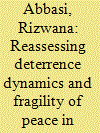

|
|
|
|
|
| Summary/Abstract |
This study reassesses conflicting strategic behavior of India and Pakistan in the changed regional environment. It predominantly focuses on evaluating the two states’ behavior in regard to their nuclear doctrines, strategies, force postures and, operational plans and their impact on deterrence stability/instability. It continues by examining the following questions: Why do these states behave distinctly on their strategic goals that make peace precarious and deterrence unstable? How far have the changing security dynamics and emerging doctrinal structures of these states made regional deterrence more or less stable? How can these states stabilize deterrence and secure regional peace? The paper finds that nuclear deterrence in South Asia apparently has stabilized the region but the peace was precariously maintained because the two states have distinct strategic direction and goals. India and Pakistan cannot avoid serious and unavoidable risks of nuclear war until they lay down their all-inclusive military plans, adopt budgetary constraints, institute an arms control mechanism and build a stable political relationship.
|
|
|
|
|
|
|
|
|
|
|
|
|
|
|
|
| 17 |
ID:
128305
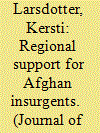

|
|
|
|
|
| Publication |
2014.
|
| Summary/Abstract |
After the fall of the Taliban regime in 2001, several thousand Afghan Taliban forces fled across the border to Pakistan, and the area became a safe haven for Afghan insurgents. In 2014, the transnational dimension of the insurgency is still highly prominent. Although regional support for insurgents is not uncommon, how to counter this aspect is mostly ignored in counterinsurgency (COIN) theory and doctrines. In this article, a regional counterinsurgency framework is developed, using the regional counterinsurgency efforts in Afghanistan as an example. The framework will facilitate the systematic inclusion of regional COIN measures in theory and doctrine.
|
|
|
|
|
|
|
|
|
|
|
|
|
|
|
|
| 18 |
ID:
116651
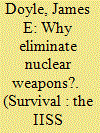

|
|
|
|
|
| Publication |
2013.
|
| Summary/Abstract |
On 5 April 2009 in Prague, US President Barack Obama asserted the United States' commitment to 'seek the peace and security of a world without nuclear weapons'. He was adding his voice and the efforts of his administration to the growing number of world leaders, citizens and civil-society organisations seeking the elimination of such weapons.1 Banning the bomb has been a passionate and often popular crusade since its creation and first use, but in all that time it has never been a serious strategic objective for any state that possessed nuclear weapons.2 Why would a sitting US president take the political and strategic risk of declaring that progress towards this goal was a key element of America's national security policy?
|
|
|
|
|
|
|
|
|
|
|
|
|
|
|
|
|
|
|
|
|